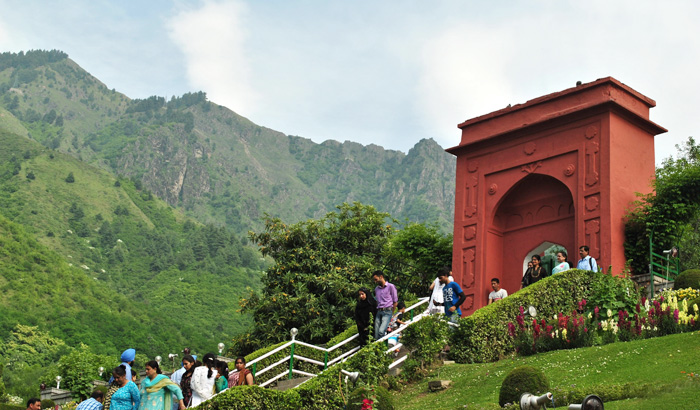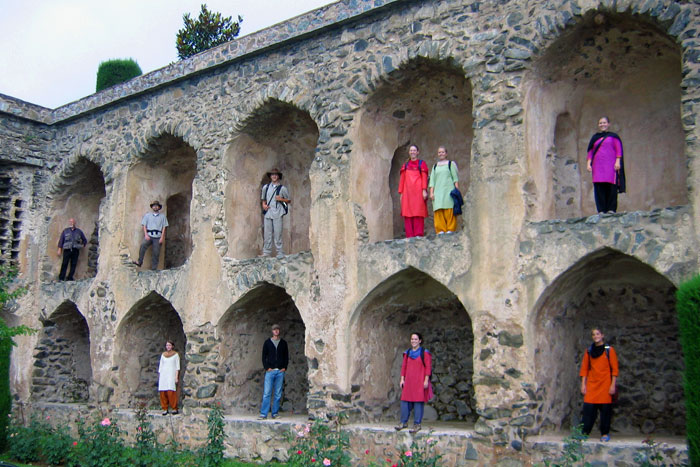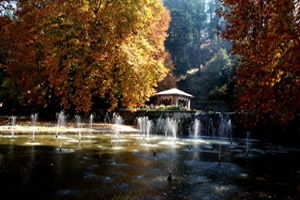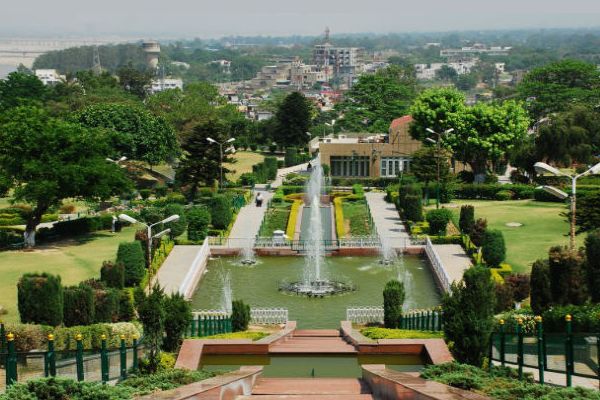

Mughal Garden, Shalimar
 Shalimar garden was built by Mughal Emperor Jehangir in the year 1619 AD and called it "Farah Baksh" (the delightful). Eleven years later Zaffer Khan the Governor of Kashmir during Emperor Shah Jahan's reign extended the garden and called it "Faiz Baksh" (the Bountiful). The garden was graded in three sections. The outer garden known as the Diwan-i-Aam, the central porrion the Emperor's garden called as the "Diwan-i-Khas" and the uppermost by far the best garden was meanc for the Empress and her ladies. The romantic effect of numerous fountains in large tanks and central water channel, cascades, and monumental pavilions, mighty chinars, lush lawns laden with colour and fragrance speak volumes for the taste of Great Mughal. The garden covers an area of 12.40 ha.15 kms from the TRC
Shalimar garden was built by Mughal Emperor Jehangir in the year 1619 AD and called it "Farah Baksh" (the delightful). Eleven years later Zaffer Khan the Governor of Kashmir during Emperor Shah Jahan's reign extended the garden and called it "Faiz Baksh" (the Bountiful). The garden was graded in three sections. The outer garden known as the Diwan-i-Aam, the central porrion the Emperor's garden called as the "Diwan-i-Khas" and the uppermost by far the best garden was meanc for the Empress and her ladies. The romantic effect of numerous fountains in large tanks and central water channel, cascades, and monumental pavilions, mighty chinars, lush lawns laden with colour and fragrance speak volumes for the taste of Great Mughal. The garden covers an area of 12.40 ha.15 kms from the TRC
Nishat Garden
 Nishat garden, the garden of Delight, the largest Mughal Garden on Dal-Lake was laid out by Asaf Khan, brother of Nur Jahan, wife of Jahangir, in the year 1632 A.D. It is located on Dal-Lake about 2.5 Kilometers to the south of Shalimar and commands a magnificent view in the west and has a panoramic back drop of mountains in the East. The garden had originally 12 terraces. Enchanting central water channel, rippling fountains in large tanks and channels and sparkling cascades amidst bountiful colours, lush lawns and mighty chinars are principal features of this pleasure garden. The garden is spread over an area of about 20 ha.
Nishat garden, the garden of Delight, the largest Mughal Garden on Dal-Lake was laid out by Asaf Khan, brother of Nur Jahan, wife of Jahangir, in the year 1632 A.D. It is located on Dal-Lake about 2.5 Kilometers to the south of Shalimar and commands a magnificent view in the west and has a panoramic back drop of mountains in the East. The garden had originally 12 terraces. Enchanting central water channel, rippling fountains in large tanks and channels and sparkling cascades amidst bountiful colours, lush lawns and mighty chinars are principal features of this pleasure garden. The garden is spread over an area of about 20 ha.
This garden of the royal spring was built in 1642 A.D. by Ali Mardan Khan, the Governor of Kashmir during the reign of Emperor Shah ]ahan. It is a terraced garden situated 9 Km away from Srinagar and about 2 Km up from the main road in a mOllntain side over-looking Dal-Lake. Fountains play in the central water channel starting from the famed spring located in the upper most terrace. It is famous for its pure, sparkling and cool mineral water. To cope up with the ever-increasing tourist traffic the garden has been extended in recent years. It has also been lit recently with multicoloured garden lights. This has proved an added attraction for tourists as well as 10cals.The garden extends over an area of 6.20 ha.
Pari Mahal
 The name Pari Mahal appears to be a distorted version of "Peer Mahal" built by Prince Dara Shikoh, eldest son of Emperor Shah ]ahan in the year 1640 A.D. for his tutor Peer Mullah Shah. Once the royal observatory, it is a seven terraced garden located on the base of Zabarvan mountain range over-looking city of Srinagar and Dal-Lake.
The name Pari Mahal appears to be a distorted version of "Peer Mahal" built by Prince Dara Shikoh, eldest son of Emperor Shah ]ahan in the year 1640 A.D. for his tutor Peer Mullah Shah. Once the royal observatory, it is a seven terraced garden located on the base of Zabarvan mountain range over-looking city of Srinagar and Dal-Lake.
The Mahal Built for the meditation and summer residence of Peer Mullah Shah is a replica of typical Mughal architecture in garden layout, water now been restored to its glory with captivating terraced gardens, motorable road up to the garden and wonderful lighring effects which look marvelous and captivating at night. It covers an area of about 3.20 ha.
Harwan
On the hillside, south of the village of Harwan (19 kms from the TRC)), remarkable remains of ancient ornamented tile pavements of the Buddhist period have come to light. The tiles depict the dresses of the people, such as loose trousers, Turkoman caps or close fitting turbans and large ear-rings which reveal Central Asian influence. It is ASI site.
Jawaharlal Nehru Memorial Botanical Garden,
Cheshmashahi, Srinagar
This beautiful landscape garden took birth in the year 1969 on the enchanting Zabarwan mountain slopes near famous Mughal Garden Cheshmashahi, over-looking the panorama of Dal-Lake. This pleasure garden complex extends over an area of about 80 hectares and consists of several styles of gardens with unending joy for seekers of solace on informal and undulated landscape. It comprises of four components- Recreational Garden, Botanical Garden, Research Section, and Plant Introduction Centre. A beautiful lake spread over an area of 17 hectares with joy riding boats is also the attraction of the garden. The garden provides a 3.5 Kilometer joyride, a pleasant water garden, inspiring colour feast of spring, fragrance and colour pageantry of roses, riot of colours in summer, changing autumn colours and captivating twitter of water falls. Over 1.5 Lakh ornamental plants, representing about 300 plant species have been planted in the garden.
Indira Gandhi Memorial Tulip Garden
Tulip garden previously named as Model Floriculture Centre, Sirajbagh, Cheshmashahi Srinagar, is spread over an area of about 30 ha situated On the foothills of Zabarwan Hills with an overview of picturesque world famous Dal Lake. This garden was conceived, conceptualized and created by Mr. Gh. Nabi Azad, the then Chief Minister, J&K in the year 2006-07. Main aim of this garden is to boost floriculture and advance tourism in Kashmir Valley. Over 12 Lakh tulip bulbs of 68 varieties of different colours sown during Nov-Dec, 2007 presented a breathtaking view.
Jharokha Mughal Garden, Manasbal
The little known Jarogabal garden is located on the steep North Eastern Bank of loveliest and loneliest Manasbal Lake. The name in all probability is the distorted version of "Daroga Bagh" also known as "Lalla Rookh's Garden". This royal palace was built for the Empress Noar Jahan. The garden which was in ruins till recently, commands a captivating view of the lake and its environs-serene and calm. It covers an area of about 3.50 ha.
Mughal Garden, Achabal, Anantnag
 This garden is believed to be laid by Nur Jahan wife of Jahangir in 1620 A.D. It is situated about 62 Km south of Srinagar. It is watered by an ancient and once sacred spring from the adjacent hillside. All its pavilions are Kashmiri in character. Fountains in water channels spray and splash and cascades tumble presenting a romantic view. The garden covers an area of about 6.20 ha. Achabal is located at the foot of a forested hill, 8 km from Anantnag and 56 km from Srinagar
This garden is believed to be laid by Nur Jahan wife of Jahangir in 1620 A.D. It is situated about 62 Km south of Srinagar. It is watered by an ancient and once sacred spring from the adjacent hillside. All its pavilions are Kashmiri in character. Fountains in water channels spray and splash and cascades tumble presenting a romantic view. The garden covers an area of about 6.20 ha. Achabal is located at the foot of a forested hill, 8 km from Anantnag and 56 km from Srinagar
Resting at the foot of a hill with a row of majestic chinars framing it, the garden of Achabal is a visual delight. They embody all that goes to make a Mughal Garden- stepped terraces, formal elegance , ornamental shrubs, sparkling fountains and falling water.
Darashikoh Bagh, Bijbehara, Anantnag
This garden is situated on the national highway about 45 Km from Srinagar on the bank of River ]ehlum.This garden was built by Dara Shikoh eldest son of emperor Shah ]ahan in the year 1640 A.D. It served as camping round for Mughal journey. Majestic Chinars add to the beauty of this garden.This garden is spread over an area of 17.15 ha.
Botanical Garden Kokernag, Anantnag
The pleasure garden of serene beauty against the backdrop of high and thick pine forests existed earlier on about 0.8 ha. in front of the famous springs of pure, cool mineral water.In 1969 the garden was extended to an area of about 26 ha. and converted into a' Botanical Garden besides being a pleasure garden. New lawns have been laid and about One Lakh ornamental plants, trees, bushes, roses, as well as flora from the wild niches of higher range has been planted. A separate section comprising of wild flora of the valley is mainrained in this garden.Modern effects like rosary, Japanese bridges over the gushing water stream, water ponds, live garden seats, topiary work etc. are points of attraction in the garden.
Mughal Garden, Verinag Anantnag
The present name Verinag is probably the deformed version of Virah-Nag in Sanskrit. It is located about 61 Kilometers south of Srinagar at the foot of Banihal hill range. The gushing spring of Verinag is the source of the river Jehlum in Kashmir.Mughal Emperor Jhangir was highly impressed by the natural beauty of this irregular spring and its surroundings and built an octagonal tank of sculptured stones around it in 1620 A.D. Seven years later his son Shah Jahan constructed cascades and fountains in straight lines in front of the spring and also hot and cold baths (Hamams) of which only ruins are now left. Its bountiful gushing water, open lawns, mighty chinars, colour and fragrance of flowers against the backdrop of a green forest are the bounties of nature one can be proud of The garden covers an area of about 5.30 ha.
Bagh-Bahu, Bahu Fort Jammu
 A terraced garden located on the slope below the Bahu Fort. The Garden has been laid out on the design of the Mughal Gardens and provides panoramic views of the Jammu city and the expanse of the Tawi river and the Trikuta Hills.
A terraced garden located on the slope below the Bahu Fort. The Garden has been laid out on the design of the Mughal Gardens and provides panoramic views of the Jammu city and the expanse of the Tawi river and the Trikuta Hills.
Rajinder Park, Canal Road, Jammu
Built along the Ranbir Canal covering a distance of a kilometer the park gets its name from Dr. Rajinder Prasad late President of India who was given a reception by people of Jammu here. The park has been spruced up and refurbished by the Jammu and Kashmir Bank some time back and is a favourite get away for the people especially in summers for the ice cold waters of the Canal.